How to Personalize Your Email Campaigns for Better Results
Understanding Your Audience
Before diving into personalization, it's crucial to understand who your audience is. Conducting thorough research to gather demographic and psychographic data will help shape your email strategy. Knowing your audience's age, location, interests, and buying habits can significantly influence how you personalize your emails.
Once you have a clear understanding of your target audience, segment them into different groups. This segmentation allows you to tailor your content more precisely, ensuring that each group receives messages that resonate with their specific needs and preferences.

Utilizing Customer Data
Customer data is at the heart of personalized email campaigns. Leverage data collected from past interactions, purchase history, and website behavior to create relevant email content. Incorporate dynamic content blocks that change according to the recipient's preferences, such as product recommendations or personalized offers.
Moreover, using personalized greetings and subject lines based on customer data can make your emails feel more personal and engaging. A simple mention of the recipient's name or a reference to their recent purchase can significantly improve open rates.
Behavioral Triggers
Behavioral triggers are another powerful way to personalize email campaigns. These triggers are automated emails sent based on a subscriber's actions or inactions. For example, sending a follow-up email to someone who abandoned their cart or a thank-you note after a purchase can enhance customer experience and encourage further engagement.

Crafting Relevant Content
Creating content that speaks directly to the interests and needs of your audience is essential for personalization. Use insights from your audience research to develop content that adds value and addresses their pain points. This approach not only builds trust but also increases the likelihood of conversions.
Consider using storytelling techniques in your emails to create an emotional connection with your subscribers. Share success stories, customer testimonials, or behind-the-scenes insights to make your emails more relatable and memorable.

Testing and Optimization
Personalization is an ongoing process that requires regular testing and optimization. Conduct A/B tests on different elements of your emails, such as subject lines, call-to-action buttons, and email layouts, to determine what resonates best with your audience.
Analyze the performance of your campaigns using metrics like open rates, click-through rates, and conversion rates. Use this data to refine your strategies, ensuring that your personalization efforts continue to deliver better results over time.
Conclusion
Personalizing your email campaigns is a surefire way to enhance engagement and drive better results. By understanding your audience, utilizing customer data, crafting relevant content, and continuously testing your strategies, you can create email campaigns that not only capture attention but also build lasting customer relationships.
Remember, successful personalization is not about sending more emails but about sending the right emails that truly resonate with your audience. Start implementing these strategies today and watch your email campaigns thrive.